Ultrasound is a Critical Tool of Managing Miscarriage
Ultrasound technology can be an indispensable tool for the management of suspected early pregnancy loss.
This story originally appeared in Diagnostic Imaging's sister site, Contemporary Ob/Gyn
Introduction
Early pregnancy loss (miscarriage) is defined as a nonviable, intrauterine pregnancy with either an empty gestational sac or a gestational sac containing an embryo or fetus without cardiac activity within the first 12 6/7 weeks of gestation.1
The cessation of development occurs in approximately 10 percent to 20 percent of clinically recognized pregnancies, increasing with advancing parental age.1-3 With the adoption of early home pregnancy testing, women are commonly referred for sonographic evaluations very early in gestation to determine pregnancy location and viability.
Although we believe ultrasound to be indispensable for the management of suspected early pregnancy failure, if performed too early or without strict adherence to guidelines, it may lead to inconclusive results or an incorrect diagnosis of an early pregnancy loss.4
Ultrasonography (usually transvaginal) in combination with β-hCG and clinical history is instrumental for making the diagnosis of a nonviable pregnancy with certainty.
Historically, these criteria were based on small studies; a CRL of ≥ 5mm and mean sac diameter of≥ 16-17 mm without an embryo were considered diagnostic for an early pregnancy loss.1,5 Over the last decade, the reliability of these thresholds has been called into question.6,7
In 2013, the Society of Radiologists in Ultrasound (SRU) convened a multispecialty panel on early first-trimester diagnosis of miscarriage and exclusion of a viable intrauterine pregnancy (cannot result in the birth of a live baby) and published a more conservative approach to defining a pregnancy as nonviable.5
This change was made with the expectation of a diagnostic specificity of 100 percent (no false positives), while accounting for intra and inter-observer variability in measurements as well as a range in practice conditions and experience.6,7 Inadvertent misclassification of potentially viable pregnancy as nonviable with resultant medical or surgical intervention resulting in the iatrogenic termination of a desired pregnancy has significant consequences to the family and may be an inciting factor in malpractice cases.8,9
This article will focus on the criteria for the sonographic diagnosis of a nonviable intrauterine pregnancy early in gestation, those sonographic findings that are suspicious to result in an early pregnancy loss, and the vital role of ultrasound in these frequent clinical scenarios.
The sonographic findings are only one part of the puzzle in determining if a pregnancy is nonviable.
In order to apply the findings to a clinical situation, the obstetric care provider must take other clinical factors into consideration, such as accounting for the certitude of menstrual dating, the woman’s desire to continue the pregnancy until the definitive diagnosis is made along with logistical challenges such as the possibility of heavy bleeding leading to emergency room visits, unexpected passage of products of conception or unscheduled surgical procedures.
On another note, when diagnosing a complete miscarriage, care must be taken that an intrauterine pregnancy has previously been confirmed. If not, serial β-hCG should be performed so as to not miss the diagnosis of an ectopic pregnancy.
Embryologic development in early pregnancy is quite linear and follows a dependable and fairly tight timetable (Figs. 1A, B, C, D).
Figure 1A
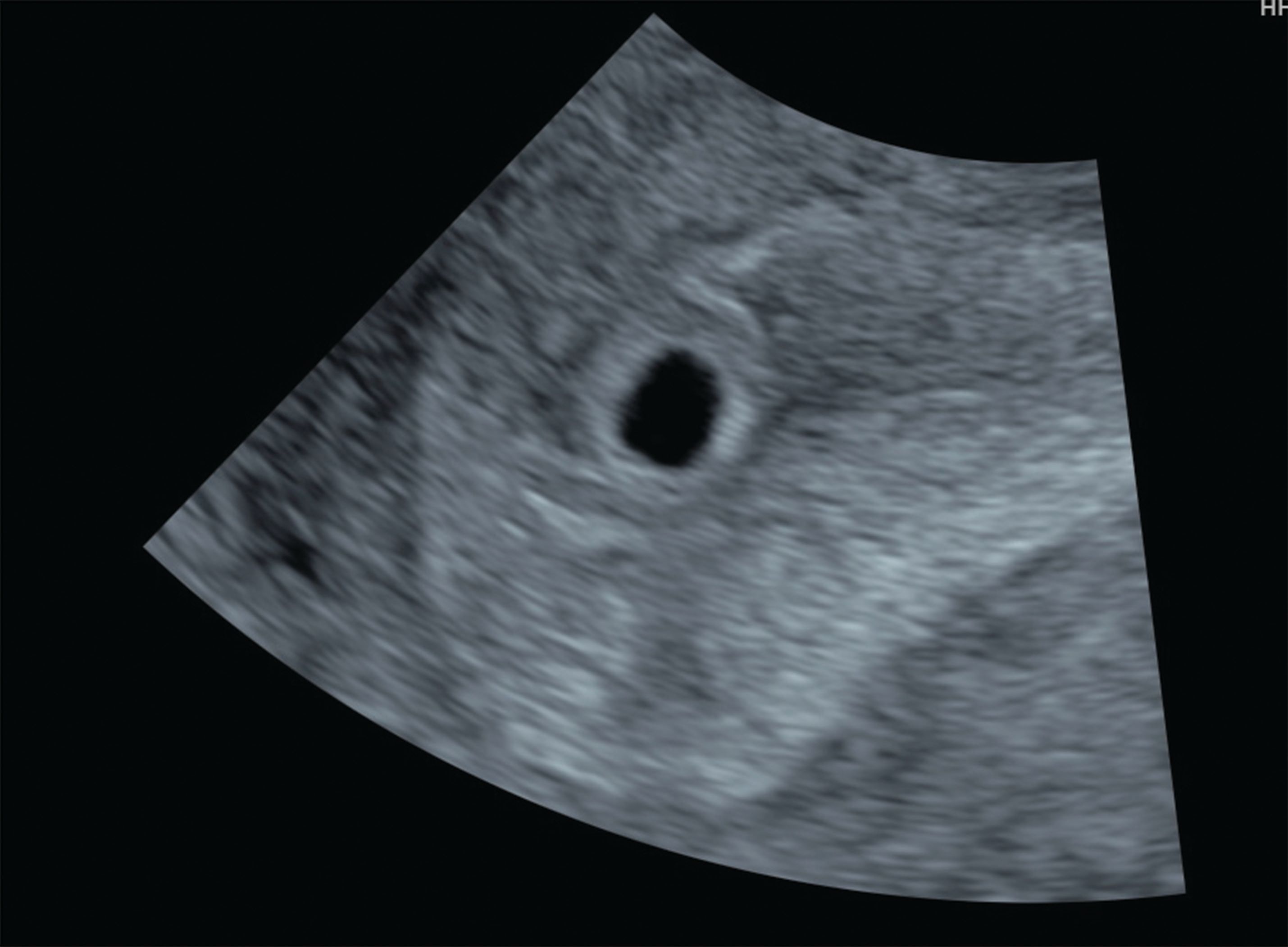
Figure 1B
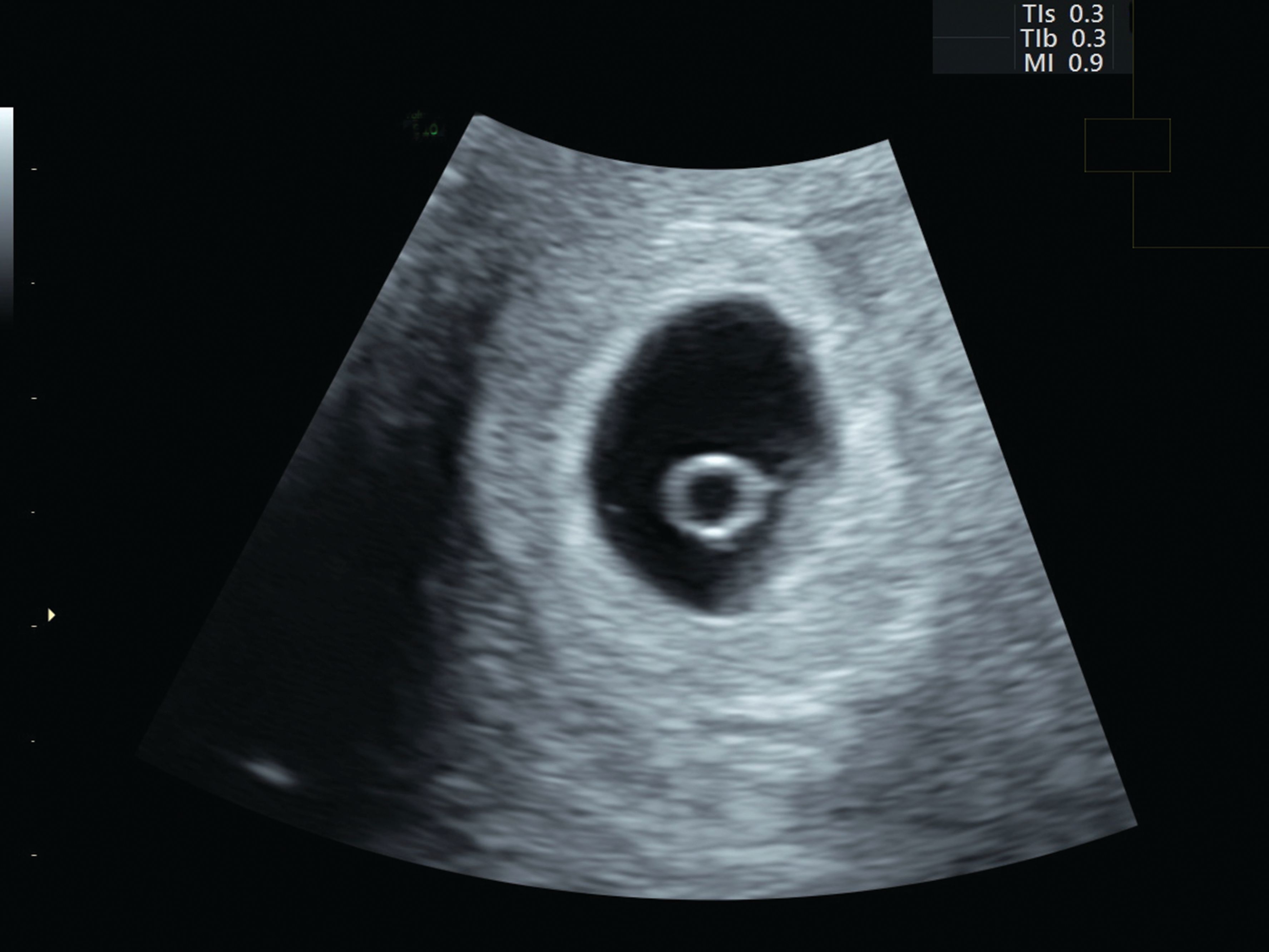
Figure 1C
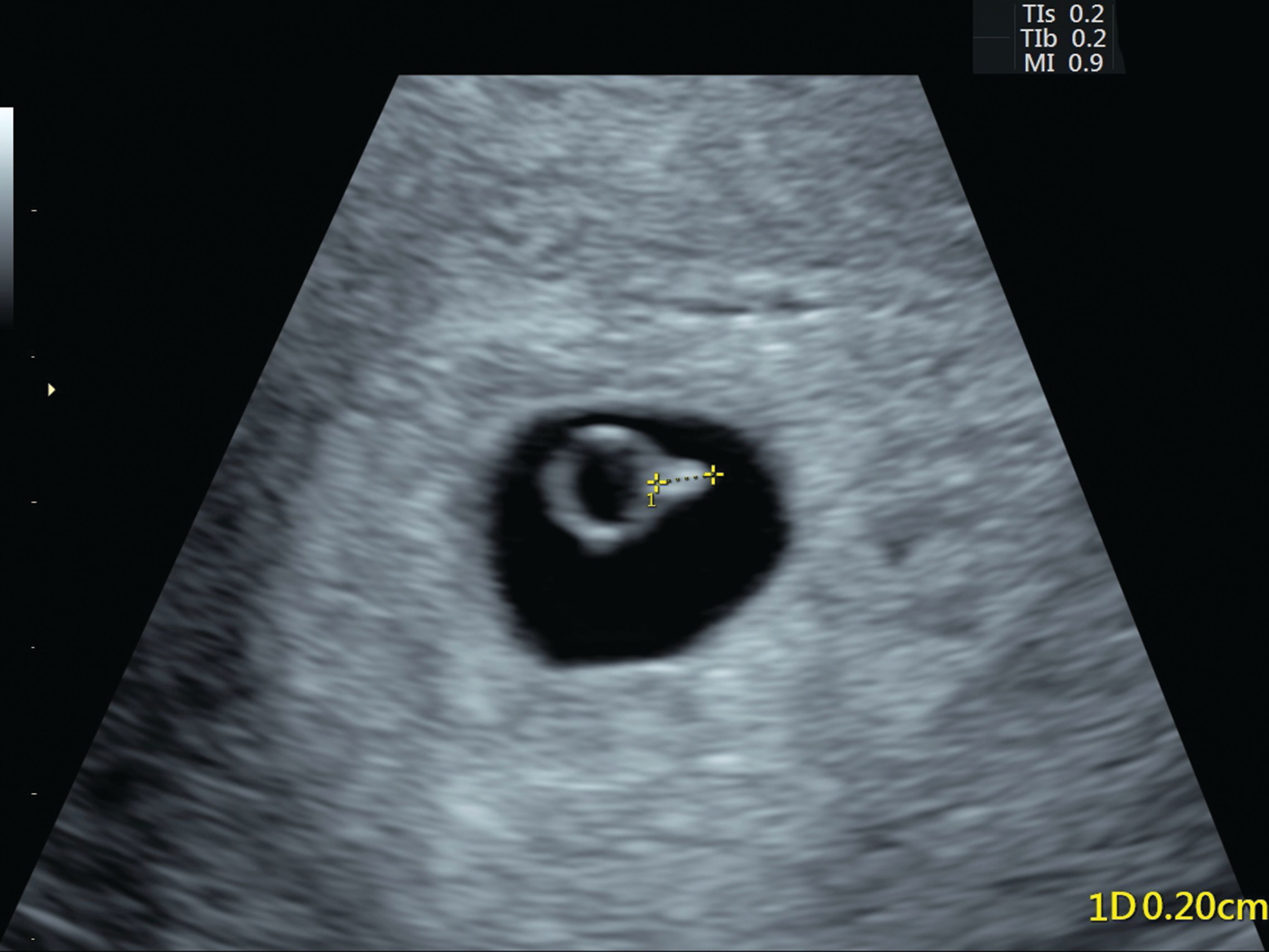
Figure 1D
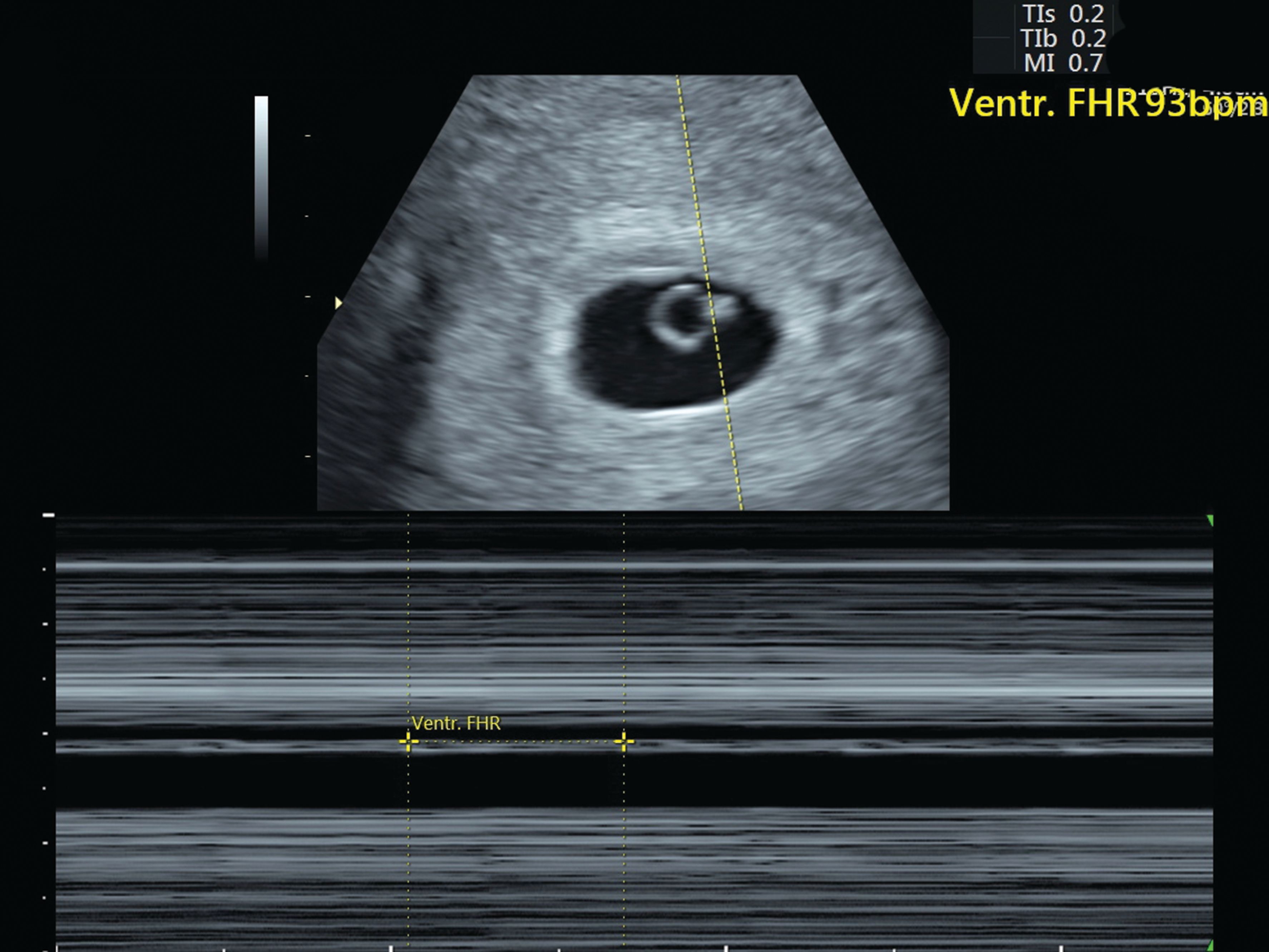
Ultrasound can reliably characterize the progression of a normally developing pregnancy from very early in gestation.
The gestational sac is first identified at approximately 5 weeks, the yolk sac is visible at approximately 5.5 weeks and an embryo with cardiac activity located in close proximity to the yolk sac should be evident at approximately 6 weeks gestation.
Embryonic cardiac activity is often seen when the embryo is first identified, measuring as little as 2 mm in length. The mean sac diameter is the average of three orthogonal diameters of the fluid portion of the gestational sac but is not as accurate as crown rump length for gestational dating.10
Nomograms for development of embryonic length, heart rate, gestational sac diameter, and yolk sac diameter are available.11,12
Transvaginal sonographic findings diagnostic of an early pregnancy loss
Given the newer, more conservative guidelines that are now well-accepted, a single transvaginal ultrasound identifying an embryo with a crown rump length of 7 mm or greater without cardiac activity or a gestational sac with a mean sac diameter of 25 mm or greater without an embryo is considered definitive proof that a pregnancy is nonviable5 (Figs. 2 and 3).
These metrics have also been validated in a prospective observational multicenter study to have a specificity of 100 percent.13
Figure 2
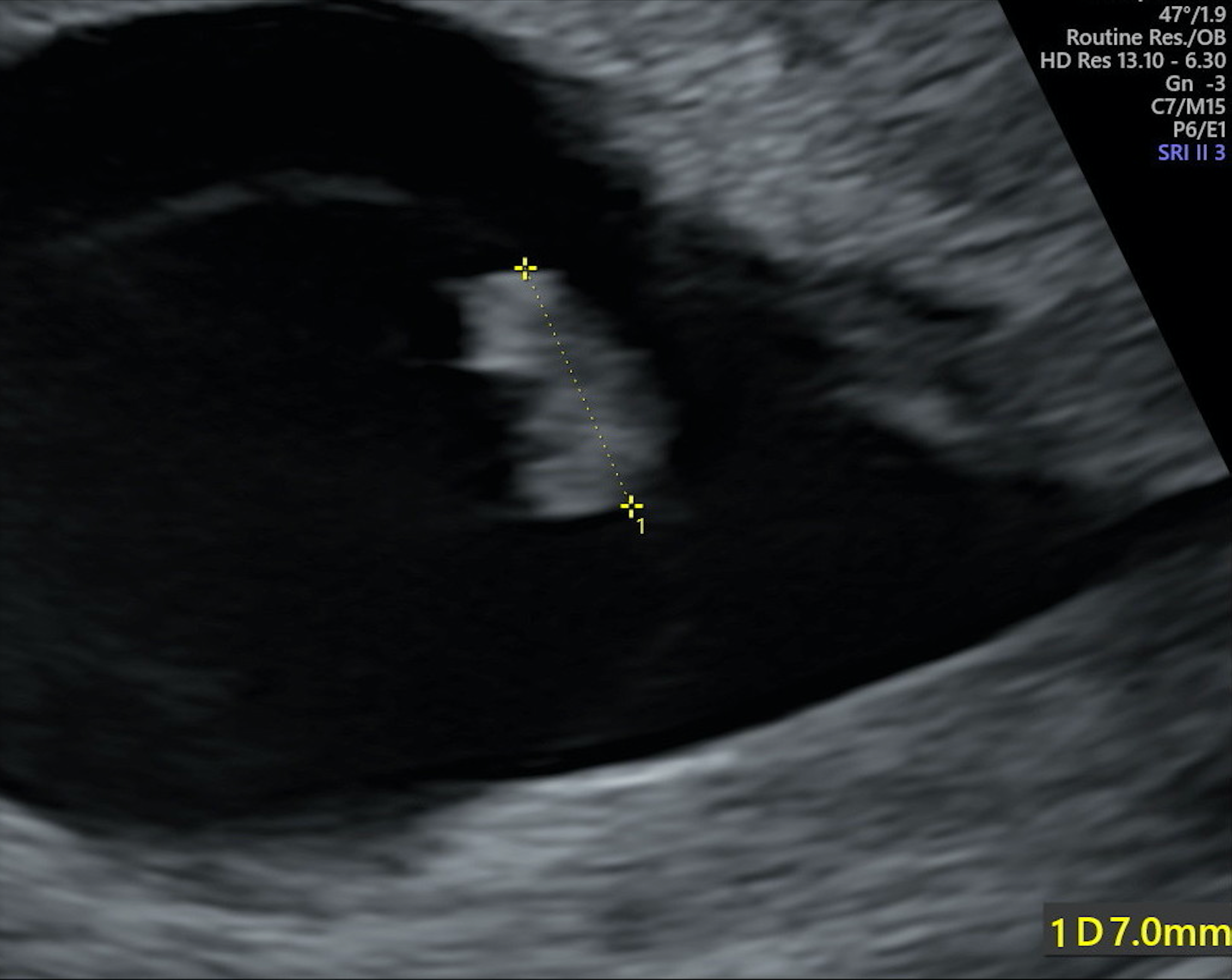
Figure 3
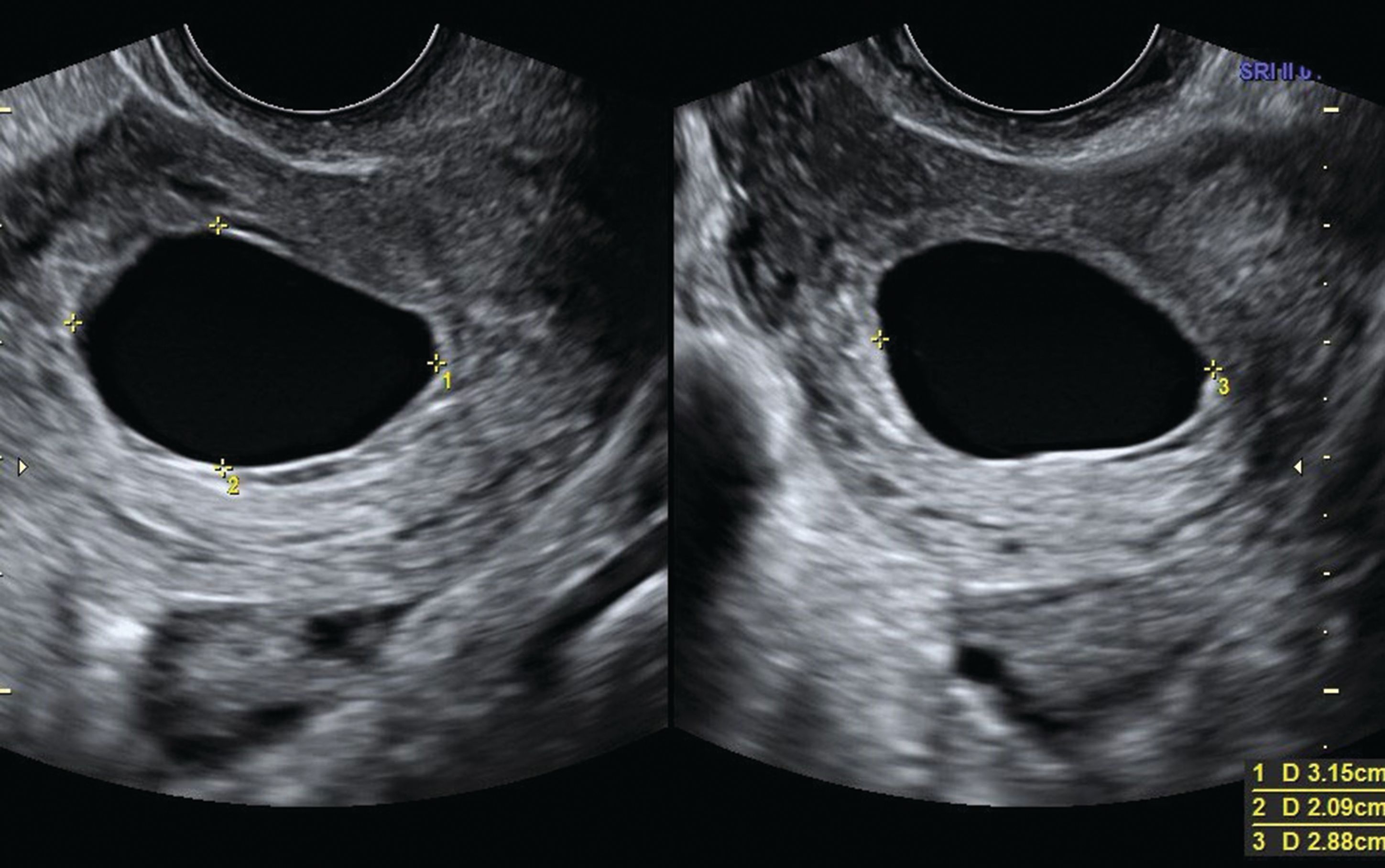
Given the expected linear development of normal early pregnancies, the definitive diagnosis of an early pregnancy loss can also be made based on sequential transvaginal ultrasound scans over a specified time interval (Figure 4).
In a normally developing viable pregnancy, an embryo with cardiac activity must be demonstrated ≥11 days after a gestational sac with a yolk sac or ≥14 days in which a gestational sac without a yolk sac was identified by transvaginal sonography.
The lack of cardiac activity after that interval of observation is definitive evidence for an early pregnancy loss. A shorter interval of observation with no embryonic heart motion would raise suspicion for an early pregnancy loss, however, it is not definitive.5,13
Predictably, patients are anxious when the results of an indeterminant status of viability are disclosed, and the rationale behind the recommended time interval for follow up of the sonographic evaluation should be communicated.
Transvaginal sonographic findings suspicious (but not diagnostic) for early pregnancy loss
If an embryo is seen with a crown-rump length of <7 mm and without cardiac activity, it is suspicious for an early pregnancy loss (Figure 5). Similarly, a gestational sac with a mean sac diameter of 16-24 mm and no embryo is suspicious for an early pregnancy loss.
Figure 5
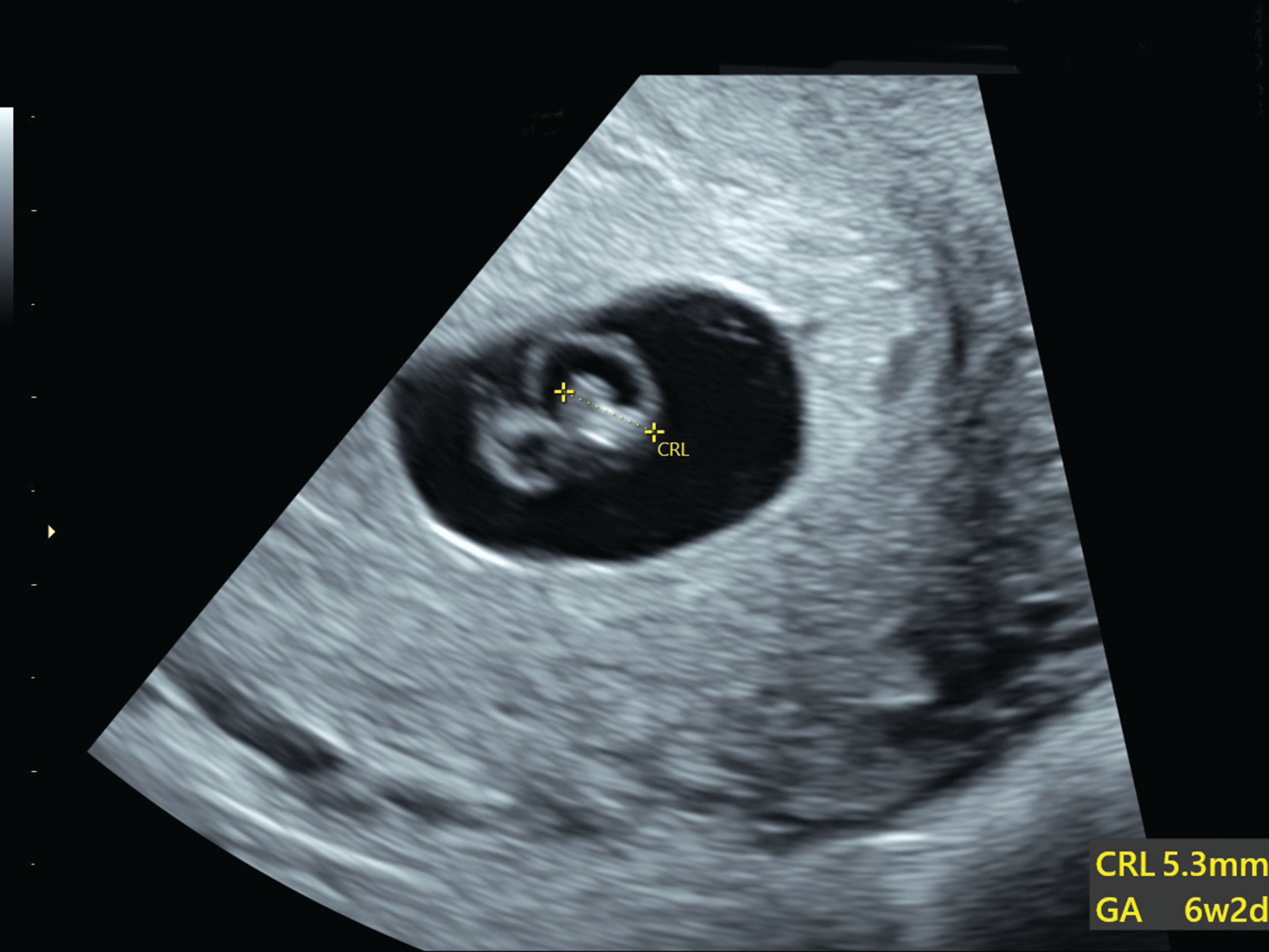
The development of gestational sac landmarks is progressive and therefore the sonographic finding of an amnion with an adjacent yolk sac and without a visualized embryo is suspicious for an early pregnancy loss (Figure 6). It is important not to mistake a second yolk sac for the amnion as may be seen with early monochorionic diamniotic twins. If ascertainment of viability is indeterminant based on a suspicious finding, it is generally appropriate to repeat the ultrasound examination in 7-10 days.5,13
Figure 6
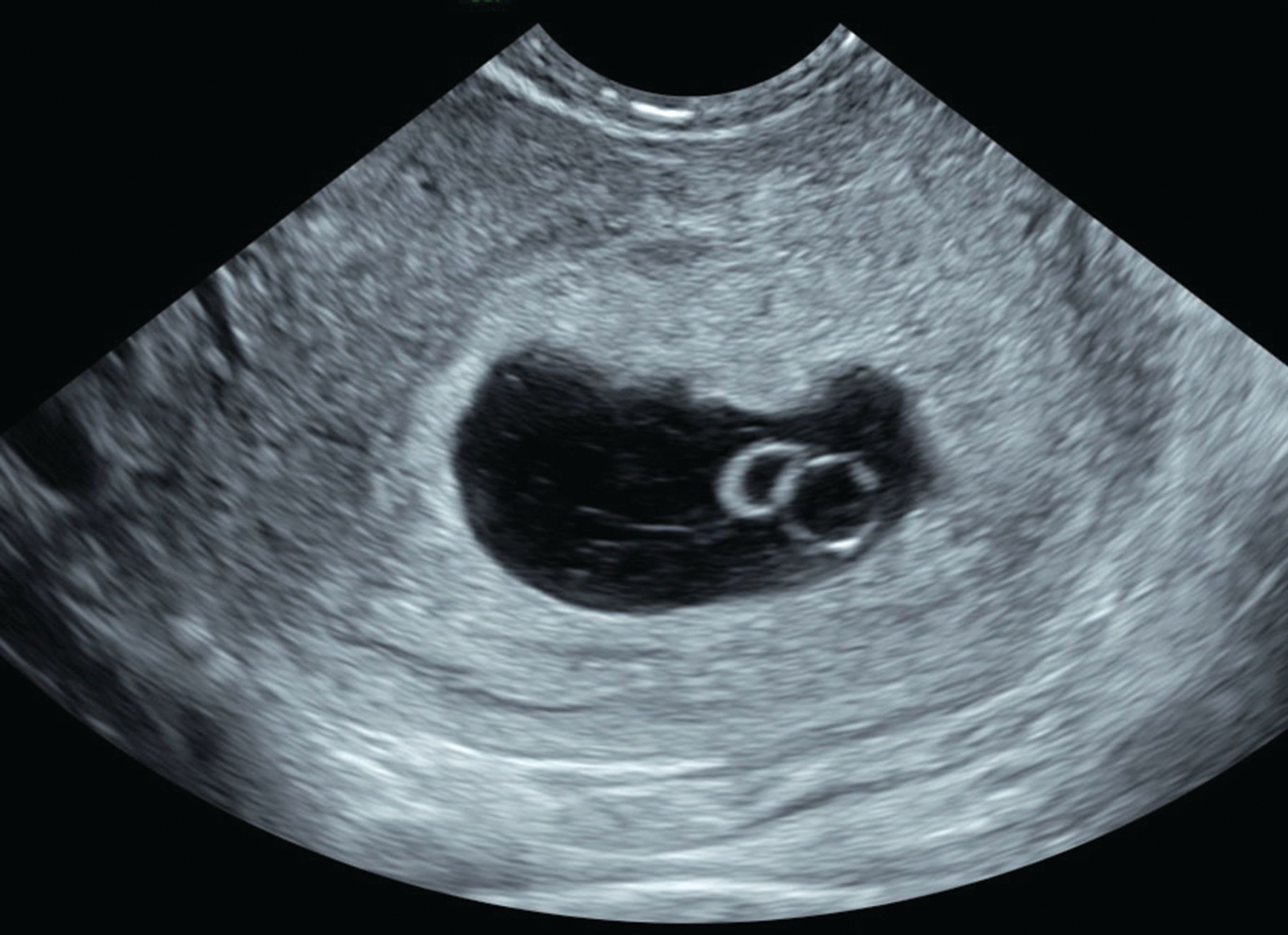
Sonographic signs concerning for an increased risk of early pregnancy loss
In embryos in which cardiac activity is demonstrated, there are additional sonographic features that may signal an increased risk for early pregnancy loss. These include findings such as embryonic bradycardia, a small gestational sac, a large yolk sac, and a subchorionic hematoma.
Embryonic or fetal bradycardia
In normal pregnancies, the embryonic heart rate progressively increases up to 8 weeks’ gestation. It has been 25 years since the seminal paper by Doubilet and Benson in which the rate of first-trimester pregnancy loss was directly correlated with embryonic heart rate 14 (Figure 7).
Figure 7

These investigators evaluated 1,185 early pregnancies and provided pregnancy loss rates stratified by the degree of bradycardia and gestational age. The slower the heart rate, the higher the risk of pregnancy loss (Table 1).
Table 1
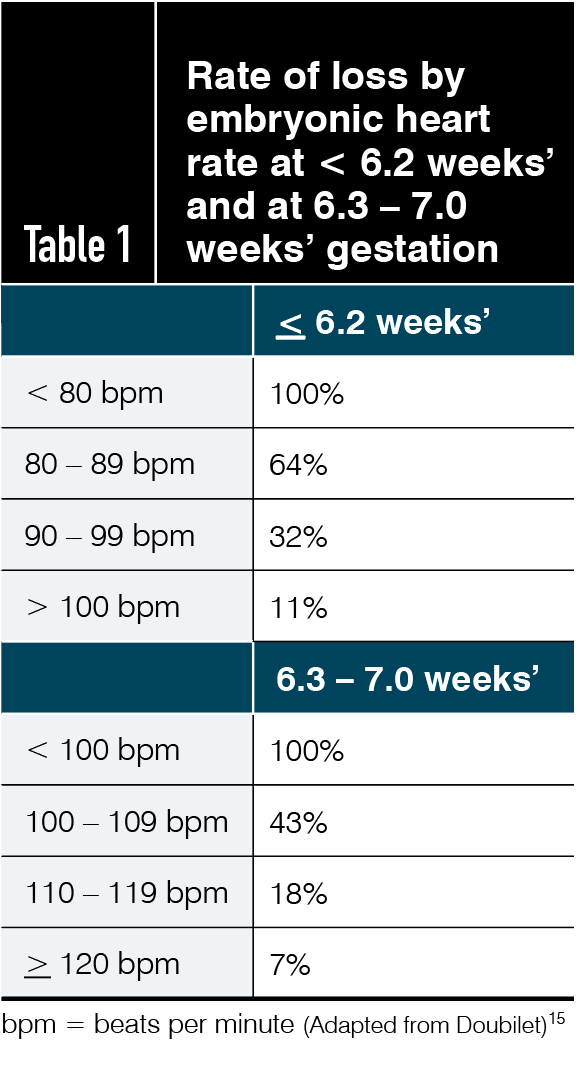
A recent systematic review and diagnostic accuracy meta-analysis evaluating the prediction of miscarriage found that the most predictive factor for early pregnancy loss was embryonic/fetal heart rate.16 This predictive effect was even more pronounced among those with bleeding in early pregnancy.
In their hierarchical summary receiver operating characteristic model curve, the authors found that bradycardia had a sensitivity of 68.4 percent, specificity of 97.8 percent, positive likelihood ratio of 31.7, and negative likelihood ratio of 0.32 for predicting early pregnancy loss.
For those with bleeding the sensitivity of heart rate to predict miscarriage increased further (sensitivity, 84.2 percent, specificity, 95.7 percent, positive likelihood ratio, 19.51, and negative likelihood ratio, 0.16).
The authors found that the best cut-off for heart rate was <110 bpm for the prediction of miscarriage. A heart rate of >134 bpm at seven weeks’ gestation and a heart rate of >158 bpm at 8 weeks’ gestation were predictive of on-going pregnancies.
These data highlight the importance of assessing embryonic heart rate by M-mode while performing an early ultrasound, as it is the most predictive sign of pregnancy loss. It must be recognized, however, that in an embryo of less than 6 weeks gestation, the very initiation of cardiac pulsations may be reflected in a slower rate,17 which underscores the value of a repeat scan.
A bradycardic heart rate should prompt a follow-up sonographic examination to assess embryonic viability, whereas a normal heart rate provides considerable reassurance for the patient.
Small gestational sac in relation to crown-rump length
On occasion, an embryo with a normal heart rate will appear sonographically ‘crowded’ within the gestational sac (Figure 8), a finding which has been associated with an increased risk of early pregnancy loss.18,19
Figure 8
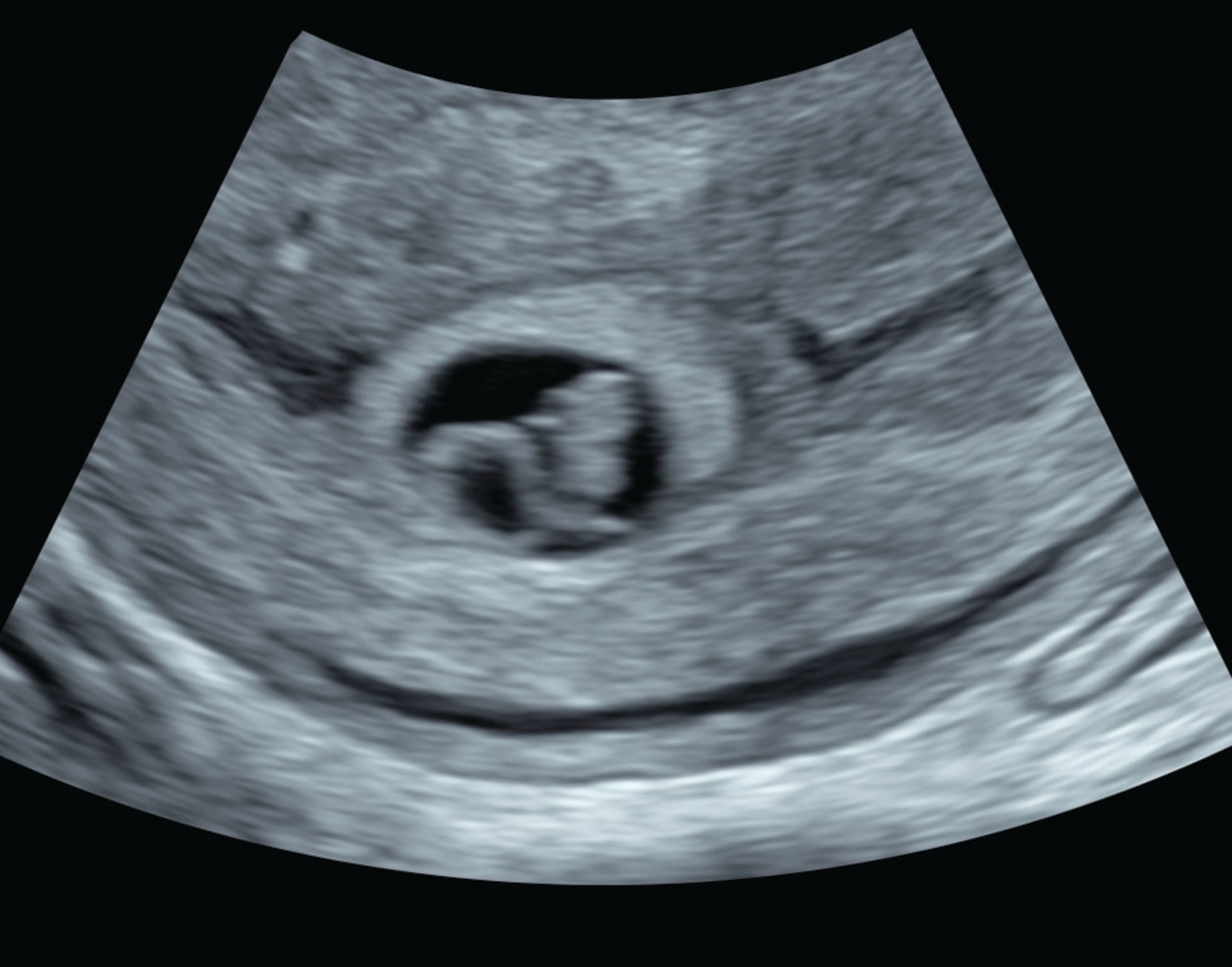
Objectively, this has been characterized as a mean sac size – crown rump length (MSS-CRL) of < 5 mm.18 Bromley et al. demonstrated that the risk of miscarriage was 94 percent with a small gestational sac in the first trimester despite a normal cardiac rate.
In a larger and more recent study of patients conceiving via IVF, the early pregnancy loss rate among patients with a MSS-CRL of< 5 mm was approximately 44 percent compared with a referent population with a MSS-CRL of 5-9.9mm in whom the loss rate was 15.8 percent (P < .0001).19
Of note, there is no appreciable increase in the risk of early pregnancy loss between those conceiving using assisted reproductive technology compared with spontaneously conceived pregnancies.20 The sonographic finding of an embryo in a small gestational sac should prompt follow-up sonography to assess persistence of development.
Yolk sac size
The yolk sac is the first structure that is identifiable within the gestational sac by transvaginal ultrasound when the gestational sac reaches 8-10 mm. Abnormalities in size and appearance of the yolk sac have been reported to be associated with an increased risk of pregnancy loss, although not all studies have found this to be a useful metric for predicting pregnancy loss.5,12,21
The sonographic assessment of the yolk sac in asymptomatic patients as a predictor of miscarriage has shown sensitivities ranging from 17 percent to 69 percent and specificities ranging from 79 percent to 99 percent.16 A yolk sac of greater than 7 mm has been suggested as a concerning threshold for an increased risk of pregnancy loss, although methods of measurement have been inconsistent.5
Recent data suggests yolk sac diameter does not improve the prediction of miscarriage over bradycardic heart rates and limited embryonic/fetal crown-rump length.22
One should be very cautious in the use of this sonographic sign, especially as an isolated finding, for prediction of first-trimester pregnancy loss until stronger guidance from the literature is available.
Crown-rump length
In a well dated pregnancy, a small crown-rump length for gestational age may reflect early growth disturbance and is associated with an increased risk of aneuploidy as well as early pregnancy loss.22 Among an IVF population with clear gestational age determination, those with a crown-rump length of < 10 percent had an increased risk of miscarriage as compared to those normally grown, 17.2 percent vs. 6.6 percent,P = 0.005, OR = 2.93, 95% CI 1.2,6.7).23
Should a much smaller than expected crown-rump length be encountered in the first trimester, especially those that would lead to a change in pregnancy dating, a follow-up evaluation to assess interval growth in 2 weeks should be considered.
Subchorionic hematoma
Bleeding in early pregnancy is common, and a subchorionic hematoma can be sonographically identified in this setting (Figure 9). Subchorionic hematoma has been associated with an increased rate of pregnancy loss, especially if the hematoma is large, associated with bleeding or the patient is 35 years of age or older.24
Figure 9
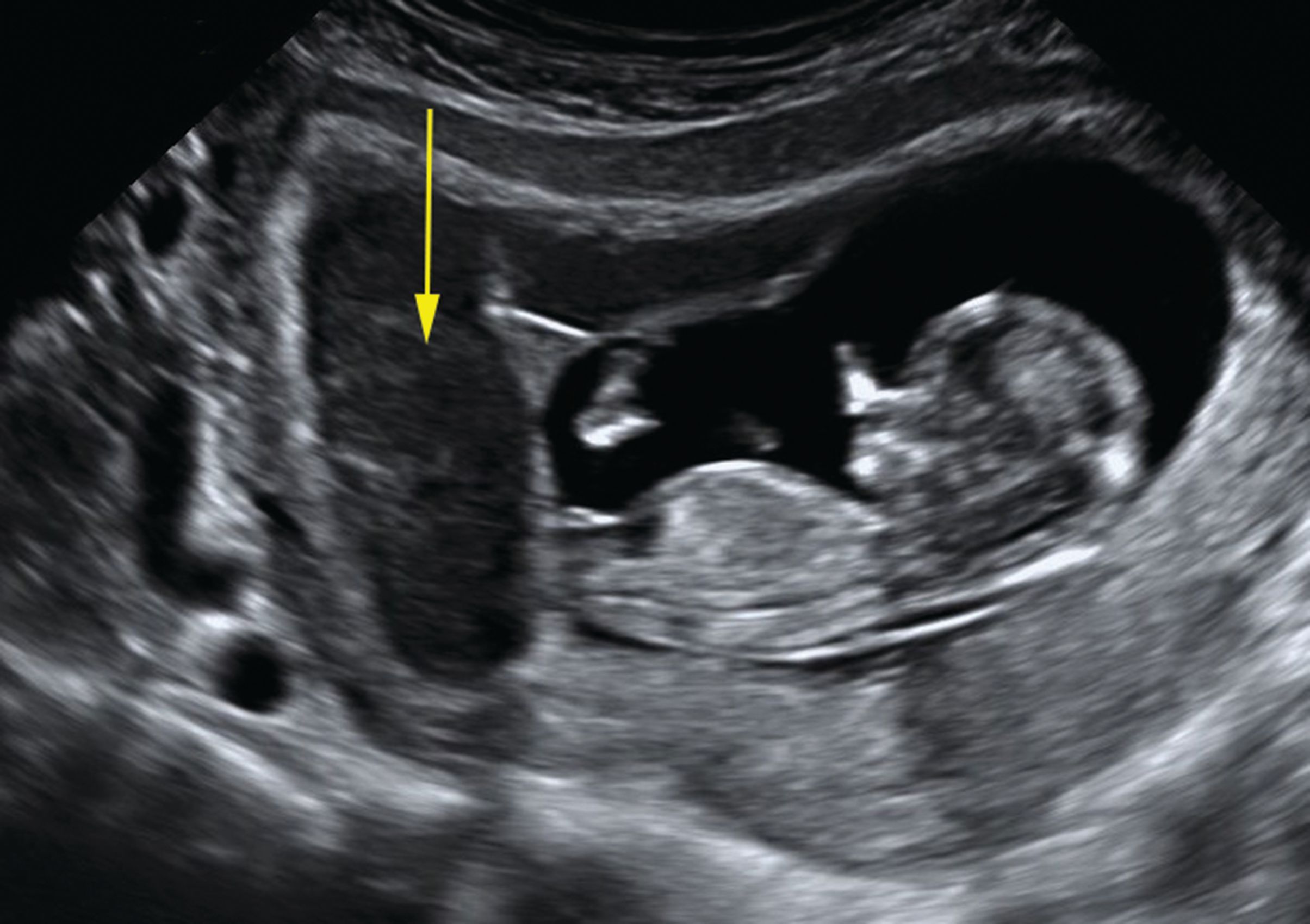
The method of assessing the size of the subchorionic hematoma has been controversial, but it appears that in one study, the subjective assessment of hematoma size based on the fraction of the gestational sac size correlates best with first-trimester pregnancy outcome.25 The rate of spontaneous pregnancy loss in the first trimester is reported to be highest for those hematomas diagnosed before 8 weeks (19.6 percent) compared to those diagnosed after 8 weeks (3.6 percent; P < .001).25
A review and meta-analysis demonstrated that the identification of a subchorionic hematoma was associated with an increased risk for miscarriage, increasing from 8.9 percent to 17.6 percent, pooled OR 2.18, 95% CI 1.29, 3.68).26
A recent retrospective cohort study of 2,446 patients with singletons presenting for ultrasound between 6 weeks and 13+6d weeks at a single center, demonstrated that subchorionic hematoma was associated with an increased risk of pregnancy loss before 20 weeks gestation (7.5 percent vs. 4.9 percent P=.026) on univariate analysis, however, when adjusting for patient age and bleeding, this association was no longer significant.27
Similarly, these authors showed no increased risk of adverse outcome later in gestation.28 Given the possible increased risk for pregnancy loss, follow-up sonography can be considered in these cases.
Chorionic Bump
A chorionic bump is a focal convex protuberance that develops at the choriodecidual surface and protrudes into the gestational sac in the early first trimester, likely reflecting a hematoma or necrotic decidua (Figure 10).
Figure 10

The finding has been associated with an increased risk of early pregnancy loss when identified before 11 weeks gestation. If a chorionic bump is identified and the pregnancy is otherwise normal in appearance with a normal heart rate, the live birth rate has been reported to be approximately 83 percent.29
In addition, there was no significant relationship between the volume of the chorionic bump or bleeding per vagina and the risk of pregnancy loss.29 In the latter part of the first trimester, the presence of a chorionic bump is not thought to be clinically relevant.30
Conclusions
Ultrasound is a powerful tool in the diagnosis and prediction of early pregnancy loss.
Practitioners must be diligent to follow guidelines for diagnosing a pregnancy as non-viable in order to prevent an iatrogenic pregnancy termination. Although some patients will have sonographic findings that definitively allow the diagnosis of a failed pregnancy, many will have findings that are suggestive or inconclusive of miscarriage. A follow-up scan can be very helpful in these cases.
The timing of the sonographic evaluation is important in management, as too early an evaluation is likely to lead to an ultrasound report of a pregnancy of unknown location or an intrauterine pregnancy of uncertain viability.
In a study of asymptomatic women attending an early pregnancy ultrasound unit, the diagnosis of a miscarriage could not be made on initial ultrasound examination until 35 days from LMP and most miscarriages were diagnosed when the first assessment was between 63 and 85 days after the LMP.4
These authors recommended that in order to reduce the number of inconclusive scans, asymptomatic women without a history of ectopic, delay an initial ultrasound until 49 days from LMP.4
Healthcare providers taking care of women suspected of having or experiencing an early pregnancy loss should have training in how to compassionately and effectively communicate difficult news as the patient is at risk for posttraumatic stress, anxiety and depression.9
About the Authors
DR. BROMLEY practices in the Department of OB/GYN at Massachusetts General Hospital in Boston and with Diagnostic Ultrasound Associates, PC, in Brookline, Mass. She is a part-time professor at Harvard Medical School.
DR. SHIPP practices in the Department of OB/GYN at Brigham & Women’s Hospital in Boston and with Diagnostic Ultrasound Associates, PC, in Brookline, Mass. He is an associate professor at Harvard Medical School.
References
1.ACOG Practice Bulletin No. 200: Early Pregnancy Loss. Obstet Gynecol. 2018;132(5):e197-e207.
2.Wise LA, Wang TR, Willis SK, Wesselink AK, Rothman KJ, Hatch EE. Effect of a Home Pregnancy Test Intervention on Cohort Retention and Pregnancy Detection: A Randomized Trial. Am J Epidemiol. 2020.
3.Ammon Avalos L, Galindo C, Li DK. A systematic review to calculate background miscarriage rates using life table analysis. Birth Defects Res A Clin Mol Teratol. 2012;94(6):417-423.
4.Bottomley C, Van Belle V, Mukri F, et al. The optimal timing of an ultrasound scan to assess the location and viability of an early pregnancy. Hum Reprod. 2009;24(8):1811-1817.
5.Doubilet PM, Benson CB, Bourne T, et al. Diagnostic criteria for nonviable pregnancy early in the first trimester. N Engl J Med. 2013;369(15):1443-1451.
6.Pexsters A, Luts J, Van Schoubroeck D, et al. Clinical implications of intra- and interobserver reproducibility of transvaginal sonographic measurement of gestational sac and crown-rump length at 6-9 weeks' gestation. Ultrasound Obstet Gynecol. 2011;38(5):510-515.
7.Abdallah Y, Daemen A, Kirk E, et al. Limitations of current definitions of miscarriage using mean gestational sac diameter and crown-rump length measurements: a multicenter observational study. Ultrasound Obstet Gynecol. 2011;38(5):497-502.
8.Shwayder JM. Waiting for the tide to change: reducing risk in the turbulent sea of liability. Obstet Gynecol. 2010;116(1):8-15.
9.Farren J, Jalmbrant M, Falconieri N, et al. Posttraumatic stress, anxiety and depression following miscarriage and ectopic pregnancy: a multicenter, prospective, cohort study. Am J Obstet Gynecol. 2020;222(4):367 e361-367 e322.
10.Committee on Obstetric Practice tAIoUiM, the Society for Maternal-Fetal M. Committee Opinion No 700: Methods for Estimating the Due Date. Obstet Gynecol. 2017;129(5):e150-e154.
11.Papaioannou GI, Syngelaki A, Poon LC, Ross JA, Nicolaides KH. Normal ranges of embryonic length, embryonic heart rate, gestational sac diameter and yolk sac diameter at 6-10 weeks. Fetal Diagn Ther. 2010;28(4):207-219.
12.Detti L, Francillon L, Christiansen ME, et al. Early pregnancy ultrasound measurements and prediction of first trimester pregnancy loss: A logistic model. Sci Rep. 2020;10(1):1545.
13.Preisler J, Kopeika J, Ismail L, et al. Defining safe criteria to diagnose miscarriage: prospective observational multicentre study. BMJ. 2015;351:h4579.
14.Bromley B, Doubilet P, Frigoletto FD, Jr., Krauss C, Estroff JA, Benacerraf BR. Is fetal hyperechoic bowel on second-trimester sonogram an indication for amniocentesis? Obstet Gynecol. 1994;83(5 Pt 1):647-651.
15.Doubilet PM, Benson CB. Embryonic heart rate in the early first trimester: what rate is normal? J Ultrasound Med. 1995;14(6):431-434.
16.Pillai RN, Konje JC, Richardson M, Tincello DG, Potdar N. Prediction of miscarriage in women with viable intrauterine pregnancy-A systematic review and diagnostic accuracy meta-analysis. Eur J Obstet Gynecol Reprod Biol. 2018;220:122-131.
17.DuBose TJ. Embryonic heart rates. Fertil Steril. 2009;92(4):e57; author reply e58.
18.Bromley B, Harlow BL, Laboda LA, Benacerraf BR. Small sac size in the first trimester: a predictor of poor fetal outcome. Radiology. 1991;178(2):375-377.
19.Kapfhamer JD, Palaniappan S, Summers K, et al. Difference between mean gestational sac diameter and crown-rump length as a marker of first-trimester pregnancy loss after in vitro fertilization. Fertil Steril. 2018;109(1):130-136.
20.Schieve LA, Tatham L, Peterson HB, Toner J, Jeng G. Spontaneous abortion among pregnancies conceived using assisted reproductive technology in the United States. Obstet Gynecol. 2003;101(5 Pt 1):959-967.
21.Taylor TJ, Quinton AE, de Vries BS, Hyett JA. First-trimester ultrasound features associated with subsequent miscarriage: A prospective study. Aust N Z J Obstet Gynaecol. 2019;59(5):641-648.
22.DeVilbiss EA, Mumford SL, Sjaarda LA, et al. Prediction of pregnancy loss by early first trimester ultrasound characteristics. Am J Obstet Gynecol. 2020.
23.Gabbay-Benziv R, Dolev A, Bardin R, Meizner I, Fisch B, Ben-Haroush A. Prediction of fetal loss by first-trimester crown-rump length in IVF pregnancies. Arch Gynecol Obstet. 2017;295(3):771-775.
24.Bennett GL, Bromley B, Lieberman E, Benacerraf BR. Subchorionic hemorrhage in first-trimester pregnancies: prediction of pregnancy outcome with sonography. Radiology. 1996;200(3):803-806.
25.Heller HT, Asch EA, Durfee SM, et al. Subchorionic Hematoma: Correlation of Grading Techniques With First-Trimester Pregnancy Outcome. J Ultrasound Med. 2018;37(7):1725-1732.
26.Tuuli MG, Norman SM, Odibo AO, Macones GA, Cahill AG. Perinatal outcomes in women with subchorionic hematoma: a systematic review and meta-analysis. Obstet Gynecol. 2011;117(5):1205-1212.
27.Naert MN, Khadraoui H, Muniz Rodriguez A, Naqvi M, Fox NS. Association Between First-Trimester Subchorionic Hematomas and Pregnancy Loss in Singleton Pregnancies. Obstet Gynecol. 2019;134(2):276-281.
28.Naert MN, Muniz Rodriguez A, Khadraoui H, Naqvi M, Fox NS. Association Between First-Trimester Subchorionic Hematomas and Adverse Pregnancy Outcomes After 20 Weeks of Gestation in Singleton Pregnancies. Obstet Gynecol. 2019;134(4):863-868.
29.Arleo EK, Dunning A, Troiano RN. Chorionic bump in pregnant patients and associated live birth rate: a systematic review and meta-analysis. J Ultrasound Med. 2015;34(4):553-557.
30.Sepulveda W. Chorionic bump at 11 to 13 weeks' gestation: Prevalence and clinical significance. Prenat Diagn. 2019;39(6):471-476.
The Reading Room: Racial and Ethnic Minorities, Cancer Screenings, and COVID-19
November 3rd 2020In this podcast episode, Dr. Shalom Kalnicki, from Montefiore and Albert Einstein College of Medicine, discusses the disparities minority patients face with cancer screenings and what can be done to increase access during the pandemic.
What New Research Reveals About Novice Use of AI-Guided Cardiac Ultrasound
April 4th 2025In a study recently presented at the American College of Cardiology (ACC) conference, researchers found that novice use of AI-guided cardiac ultrasound after an AI-enabled electrocardiogram increased the positive predictive value for reduced left ventricular ejection fraction (LVEF) or aortic valve stenosis by 33 percent.










